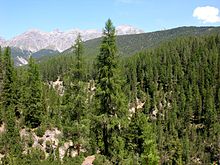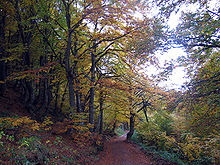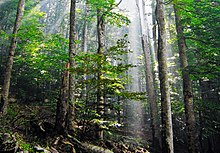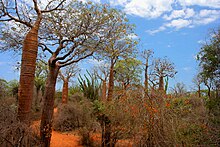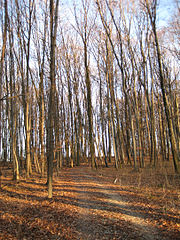Forest loss and management
Main articles: Forestry, Logging and Deforestation
Coastal Douglas fir woodland in northwest Oregon.
Redwood tree in northern California redwood forest, where many redwood trees are managed for preservation and longevity, rather than being harvested for wood production.
The scientific study of forest species and their interaction with the environment is referred to as forest ecology, while the management of forests is often referred to as forestry. Forest management has changed considerably over the last few centuries, with rapid changes from the 1980s onwards culminating in a practice now referred to as sustainable forest management. Forest ecologists concentrate on forest patterns and processes, usually with the aim of elucidating cause and effect relationships. Foresters who practice sustainable forest management focus on the integration of ecological, social and economic values, often in consultation with local communities and other stakeholders.
Anthropogenic factors that can affect forests include logging, urban sprawl, human-caused forest fires, acid rain, invasive species, and the slash and burn practices of swidden agriculture or shifting cultivation. The loss and re-growth of forest leads to a distinction between two broad types of forest, primary or old-growth forest and secondary forest. There are also many natural factors that can cause changes in forests over time including forest fires, insects, diseases, weather, competition between species, etc. In 1997, the World Resources Institute recorded that only 20% of the world's original forests remained in large intact tracts of undisturbed forest.
[9] More than 75% of these intact forests lie in three countries - the Boreal forests of Russia and Canada and the rainforest of Brazil. In 2006 this information on intact forests was updated using latest available satellite imagery.
Canada has about 4,020,000 square kilometres (1,550,000 sq mi) of forest land. More than 90% of forest land is publicly owned and about 50% of the total forest area is allocated for harvesting. These allocated areas are managed using the principles of sustainable forest management, which includes extensive consultation with local stakeholders. About eight percent of Canada’s forest is legally protected from resource development (Global Forest Watch Canada)(Natural Resources Canada). Much more forest land — about 40 percent of the total forest land base — is subject to varying degrees of protection through processes such as integrated land use planning or defined management areas such as certified forests (Natural Resources Canada)
